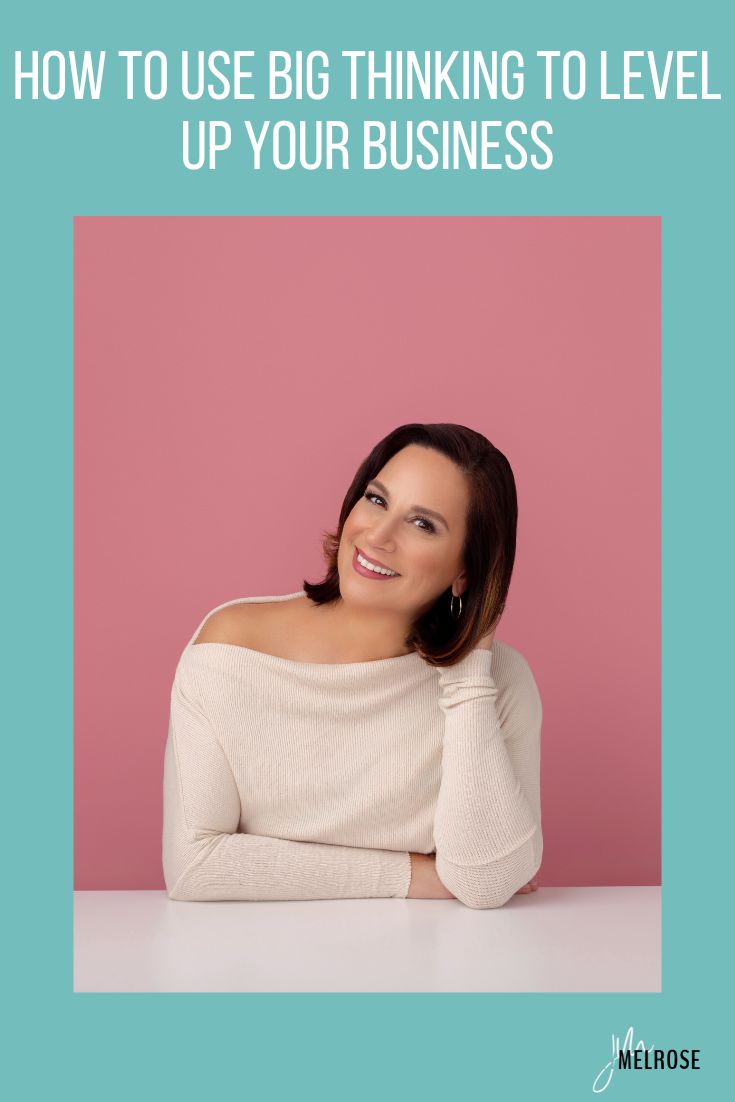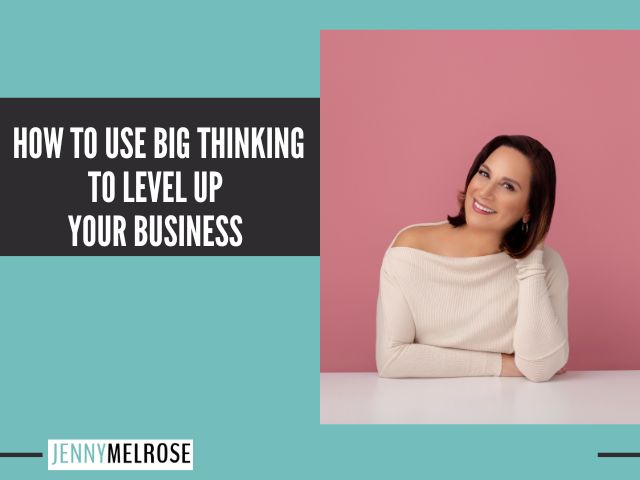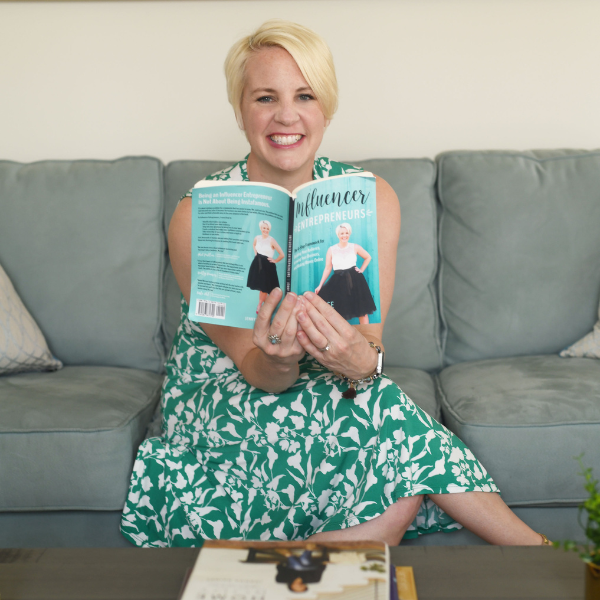Discover how to elevate your business through big thinking strategies in this insightful interview with Andrea Liebross.
Learn actionable tips and advice on scaling your business to new heights.
IE 407: How to Use Big Thinking to Level Up Your Business with Andrea Liebross

Andrea Liebross is a business coach who works with female entrepreneurs to help them “think bigger” about their businesses so they can create more freedom of time, money, and energy they crave and desire.
She helps them get back to the place and the reasons they got into business to begin with. Her website is AndreaLiebross.com
What is BIG thinking?
Big thinking is what comes from what Andrea calls “Future You.” This is the you a year from now (or 3 years, 5 years, 10 years from now) who has accomplished or is living the life you want to live and has done all the things.
If you talk to that “future you” and ask them what you should be doing today, that is big thinking. If you have your eye on the prize or believe that you can be that future you, the actions you are going to take are going to come to you.
You won’t have to sit down and struggle with the next steps. If you are doing big thinking, what’s next will come.
When thinking about “past you,” you often project the future based on the past. “I just know, based on the past, this is what is going to happen” or “This isn’t what is going to happen.” or “This is what I tend to do or don’t tend to do.”
If we stay relying on the past, we are never going to create what we want to create. The past truly is the past. It is a bunch of thoughts about what happened.
The past can be a teacher but it is not a fortune teller. The past is not going to tell you what is going to happen in the future.
If we ask our “present-day selves” what we should do, present-day self hasn’t done or isn’t at the place where you want to be, where that future you is. Present day you doesn’t necessarily know what it should be doing.
On coaching calls, Andrea often hears “I just don’t know what to do next.” If you can access that thinking of the future you, doing what you need to do today is going to come pretty easily.
Big thinking does involve some belief. If you look up the definition of the word “manifesting,” the word belief is in there. It does involve some belief but it trickles down to “What are the actions I need to take today? How should I be spending my most valuable resources of time, energy, money, and relationships? What do I need to do?”
Future you will normally have some level of confidence because they have done the things.
You will be infiltrating the level of confidence, even though you haven’t done the thing yet, but adding it to what you want to do to continue to the next step. Confidence is the willingness to feel any feeling.
Andrea talks about the real problem. This isn’t really a problem but more that you don’t want to feel a negative feeling, feel inadequate, feel like you are not enough, or feel scared.
Confidence is the ability to be okay with feeling those things as you are working through something.
Jenny often tells her clients that they are not growing unless they are feeling uncomfortable. The uncomfortable feeling is the growth.
It is the scary feeling of never having done something before and feeling uncomfortable with it. That is where the growth happens. Everything you ever wanted is on the other side of uncomfortable.
How does BIG thinking differ from small thinking?
Small thinking is going back to the past person of yourself. It is also not being willing to get out of the safety zone.
Our brains function on the Motivational Triad. We want everything to be easy, efficient, and comfortable.
Small thinking is easy, efficient, and comfortable. Doing the same thing that you have been doing, even if you don’t like doing it or don’t think it is the right thing, is easy because you have already done it before. It is comfy because you are used to it. This is what small thinking is.
There is also a concept of “Happiness set point.” Let’s use losing weight as an example. You go on a vacation and you gain weight. If you are really sick, you might lose weight.
In either example, a week or so later, your weight is back in the same place. Our body has a set point where it just likes to hang out, whether we like it or not.
The same thing goes with our thinking. Some of us like to live in chaos. We like overwhelm. It is what we are used to. Small thinking is just staying at that set point and not being willing or wanting to adjust it.
How do you become a BIG thinker?
If we want to grow our business, big thinking has to be a part of it. To become a big thinker, you have to do 5 things.
- T – Thought Options
- R – Real Problem
- U – Unknown or Uncertainty
- S – Securing Support
- T – Take Action
Thought Options: Recognize that you have thought options on how you want to think about anything. You can decide that an 80-degree day is the best day ever and you are going to stay outside all day long. Or you can decide it isn’t so fun because you have to be inside all day and work. These are two different thoughts. Big thinkers know there are thought options and use that as leverage to get them where they want to go.
Real Problem: The real problem is you don’t want to feel a negative feeling.
Unknown or Uncertainty: Embracing the unknown or uncertainty. If you are going to be a big thinker, you have to be okay with not knowing exactly what is going to happen.
Andrea gives the example of being on a consult call with a prospective client, and after the questions and discussion, she asks the question “Are we going to move forward?” That is met with “I think so but I don’t make quick decisions. I need a day or two to think about things.”
Andrea then asks to coach them through the thinking process and asks them exactly what they are thinking about in the next 24 hours before they say yes or no.
No one really has a great answer. They are thinking about “Is this going to work? Is this exactly what I need? What if it’s not?”
All of these questions are about the unknown. No one can tell you that. Big thinkers are willing to take the risk and embrace the unknown or uncertainty.
Securing Support – When Andrea asks someone who supports them, the number one answer she gets is family. It could be financial support or emotional support, whatever that looks like.
While family support is good, big thinkers have someone or something to tell them what they cannot see themselves or ask them about options they might need to consider.
Securing support outside your family is key. Inside your family, their job is to love you and not necessarily push you or tell you the hard things because it might inconvenience them in the end.
All big thinkers have some kind of support outside of their family in the form of a coach, mentor, board of directors, etc.
Take Action – Andrea calls this “massive action” as opposed to “passive action.” Passive action is what our brains want to do; comfortable, efficient, and easy. Examples of this are listening to a podcast, reading a book, or googling.
While you are doing something, it isn’t stuff that is going to move the needle.
Big thinkers take massive action alongside passive action. They are willing to take massive action which could be risky but also somewhat exciting. This action is what future you is fueling you to do.
Jenny hears from a lot of clients that they are in the research phase. When they take the leap and do the testing of it – the policies, strategies, and things that they are trying to put into action – are the things that are going to move the needle on the business.
Andrea describes this as a science experiment. You want to test things out, try things, and see what happens within certain time periods. Then you can decide what is working or not working.
No one on Google can tell you this because they are not you or your business. Your voice and positioning are factors. What works for one person will not work for another.
Why is BIG thinking non-negotiable if we want to continue to grow our businesses and ourselves?
If we are going to grow our businesses or ourselves, we have to go into an extraordinarily committed state. When you are extraordinarily committed, then you are going to create extraordinary results.
Big thinkers can differentiate whether or not they are just interested in something versus committed. A lot of times when we stay in the small thinking, we are in the just interested phase.
For example, one of Andrea’s clients has been talking about getting a new product out for a while. Once they started taking it apart, they realized she was only just interested in putting the offer out there but she wasn’t committed. Her brain hasn’t said “Yes, I am all in.” yet.
There are so many things that humans are just interested in. You are interested in working out five days a week but have you committed to it? Are you taking the action to make it happen? Are you figuring out what that is going to look like?
It is non-negotiable in that big thinkers have to commit and not just be interested. If you are in the just interested phase, you are probably just staying safe.
Most people who are successful and have gotten where they want to go have taken a risk. Everyone defines success differently but those people did big thinking and took some risks. They did T-R-U-S-T themselves as they worked toward their goal of fulfilling the dream.
What happens when you make the shift and BIG thinking becomes a habit?
Habits are tied to something. There are routines, habits, and rituals. When it is a habit, you associate it with something. It is a habit to brush your teeth when you wake up.
If big thinking can become a habit, it becomes a habit associated with your business growth. You do big thinking when you want to grow.
When you don’t want to grow, you stay in the small thinking. It has to be tied to something and have some reward.
You want to see yourself in a different place. You want to develop yourself as a thought leader. You want to help more people with your services. Whatever it is, it has to have some sort of reward.
Jenny is a routine person. She thinks that if you have a routine, it is easier to get things done, and you will be more productive in doing the strategies you put into place to move things forward. You need to create a plan and put it into habit.
You need to look at your goals at least once a quarter, if not once a month or once a week. The framework you create has to be reevaluated, tweaked, refreshed, and moved forward regularly. If you don’t, you get into a low-value cycle, which is for small thinkers.
Big thinkers have high-value cycles. If you set out to test something, for example, limiting your social media to only Instagram. At a certain point, you have to evaluate. Using a clock for a visual, think about the 15-minute, 30-minute, and 45-minute marks.
At the 15, if your number of inquiries has gone down and it isn’t working, low-value thinkers will just toss that experiment out the window. “That didn’t work. Back to the drawing board.”
If you are in a high-value cycle or doing big thinking, you might just tweak it and continue. At the 30 mark, you reevaluate those tweaks and tweak more.
Reevaluate those tweaks later at the 45-minute mark. The high-value cycle goes all the way around the clock. The small value just gets to 15 minutes, tosses it out, and starts again. This is a total waste of time.
As female business owners, we are afraid of numbers. We want to create content and be creative but we don’t necessarily want to look at the numbers.
Sometimes, this is because we don’t know what numbers to actually look at to use data to provide actual thought strategies that will continue to move us forward. When we are looking at that, we are trying to figure out what data points are going to be beneficial for what we are measuring rather than trying to connect it to what didn’t work.
Why didn’t it work? Did you not get engagement? Did you not get comments? Did you not get followers?
Often, people don’t know what they are connecting that action to. If you don’t know that, it is not going to work. You have to have that reevaluation and hone it a little bit.
How are your results different in your business and life with BIG THINKING?
Number one, it becomes a lot more fun. How can we make things simple, doable, and fun? It does become more fun because you are trying more things.
It becomes simpler too because you have eliminated some of the decision drama. You are just going to go for it. Decision drama creates business lag so you don’t stay in the decision drama too long.
What is doable? You don’t know until you try.
Big thinking makes your life and business a lot simpler. It makes it doable in the sense that you are doing things and figuring out if they are doable or not. And it does make it fun.
That fun is the joy that many of us started the idea of our business with. We wanted more joy in our lives and we saw the business opportunity as a way to bring that. Being able to have that fun is key.
She Thinks Big Tool Kit
This is a set of documents that go with the book She Thinks Big. It dives deeper into the concepts in the book, such as interested versus committed. It helps you figure out what you should be delegating and what you should be doing. There are 5-6 different parts and each is a separate tool to help you think bigger. Grab the toolkit here.
Action Steps:
- If you liked this episode of Influencer Entrepreneurs, please subscribe and leave a fabulous review!
- Join the conversation on Instagram by tagging Jenny when you’re listening to the podcast. She’ll send you a personal message whenever you tag her.


